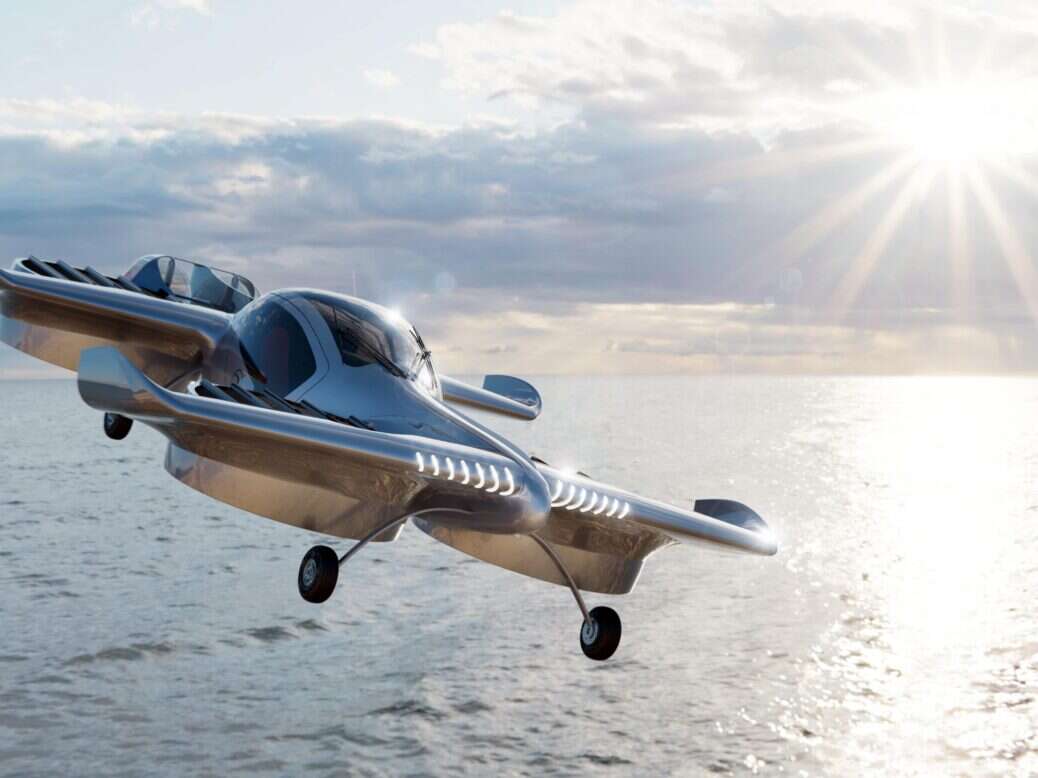
“We all knew flying cars were coming. It was just a matter of time, right?” says Doron Merdinger from his office in Coral Springs, Florida. Not all of us, however, decide to try our hand at turning science fiction into reality.
While the concept design for Merdinger’s Doroni H1 might not look the same as the iconic flying vehicles that glide through a dystopian Los Angeles in Ridley Scott’s 1982 movie Blade Runner, it’s not a million miles away either.
The two-seat eVTOL (electric vertical takeoff and landing vehicle) has two sets of wings with large, ducted propellers and wheels so it can be rolled into a garage. Unlike aircraft – or indeed cars – the Doroni H1 flies with “three clicks of a button”, and, Merdinger hopes, future owners will need just 20 hours of flight training and a regular driver’s license to operate it.
[See also: AIR Announces First Successful eVTOL Hover Flight]

For now, the Doroni H1 remains a concept. But, Merdinger says, they’re hoping to run test flights by the end of the year and start deliveries by the fourth quarter of 2024. When I ask what the interest has been like so far, the CEO and founder of Doroni Aerospace beams with pride. “It’s been crazy,” he says. “Let’s just say I’m not concerned about sales.”
Merdinger always knew he had a creative side. Growing up in Israel, he had asthma and couldn’t do much sport. So, while the other kids were running around outside, he spent most of his time in his room making sculptures and taking apart tape recorders and record players to see how they worked.
After studying microelectronics and computers at high school, he served in the Israel Defence Forces for three years working closely with drones, before graduating from New York University School of Business. On his return to Israel, he set up his first company developing products using 3D printers, before moving back to the US with his family.
It wasn’t long before a call from his mother-in-law spurred him into setting up another business. “She said to me ‘Doron I’m very angry with you,’,” he recalls with a wry smile. “I know I’m a good husband and father, so I was thinking ‘What have I done?’”
In fact, she reminded him about an idea he had, over 15 years ago, to develop a smart watch. At the time, the Apple watch had recently been released in April 2015, quickly becoming the planet’s bestselling wearable device. “She asked me, ‘Why didn’t you do it?” says Merdinger.
Unable to provide her with an answer, the ambitious entrepreneur began thinking about the next product he would develop. At this point, you could be forgiven for wondering; why flying cars? After all, the eVTOL market is fiercely competitive with aircraft heavyweights like Boeing, Honda and Embraer all throwing their hats into the race.
For Merdinger, there was a single moment that determined his fate. “I was stuck in a traffic jam, and I saw this kid playing with a drone,” he remembers. “I watched how the drone was behaving in the air and I thought ‘Why aren’t we doing this with cars?’”
“I went back to my lab, which is my safe haven, and began thinking about how I saw the future. And I said to myself: ‘flying cars’. Then this passion and drive came to me, and I just thought ‘F*** it, I’m going to do it.’ Because at some point, you have to take a leap of faith.”
Merdinger set about building a passionate team (“I like to call them anarchists”) and, later in 2016, launched Doroni Aerospace. But it was winning second place at the Florida Aerospace and Aviation Forum last year that placed his company firmly on the map as one to watch in the eVTOL market. Since then, the business has raised over $1.8m in crowdfunding.
Getting to this point hasn’t been easy and Merdinger has faced his fair share of critics along the way. “We advertise a lot on Facebook, and we were bombarded by people saying it was a scam, which at the beginning hurt me a lot,” he recalls. “You wouldn’t say that to the Wright brothers. But I understood, over time, that was their lack of belief. I have total faith in our design and my team.”
Other challenges come in the form of regulations. Even when the Doroni H1 is airborne, it will still need to undergo a certification process with the FAA, while a network of air corridors at different altitudes will have to be established in major cities to make advanced air mobility a reality.
But Merdinger is bullishly confident in his flying car and the benefits it will unlock. For a start, he says, its electric motor will be much quieter, smoother and less polluting than the combustion engines that power regular aircraft. Perhaps most importantly, he stresses, the Doroni H1 will be extremely safe thanks to its eight separate propellers, strong carbon fiber shell, anti-collision sensors and a ballistic parachute that can be ejected from the back to land the vehicle.
[See also: Elite Traveler Reveals Top 100 Suites in the World]
The CEO has ambitious plans to “democratize aviation” and usher in a new generation of private flyers. With a starting price of $195,000, the Doroni H1 will certainly be much cheaper than regular aircraft and indeed many supercars. Merdinger acknowledges this is still unattainable for many, but, he says, in time he hopes to introduce different models at lower prices as the technology becomes more widespread.
So, what can future owners expect from the Doroni H1? Crucially, the eVTOL isn’t much bigger than a car so it can easily be stored and charged in a two-car garage at home. As for the flying itself, the vehicle will have just three buttons and will operate semi-autonomously cruising at an altitude of 500 – 1,000 ft. To begin with, Merdinger and his colleagues are focused on introducing eVTOLs to remote areas where it won’t be necessary to establish a network of air corridors, before turning their attention to cities.
Above all, Merdinger has unwavering confidence in the Doroni H1 and is adamant there will come a time when “every person in the world will have a personal flying car” and roads become obsolete. His eyes light up as he launches into a list of potential applications for his eVTOL, from search and rescue missions to sightseeing excursions.
“I think there will come a point where you’re coming out of the pub, you’ve had a few drinks, and instead of driving your car home, you call your Doroni. It will fly to you, land next to you and take you home,” he says. “It might not be tomorrow, but I can see a bright future. There’s a different world and I can’t wait for people to experience it.”
[See also: The Private Aviation Leaders Taking Sustainability Seriously]






